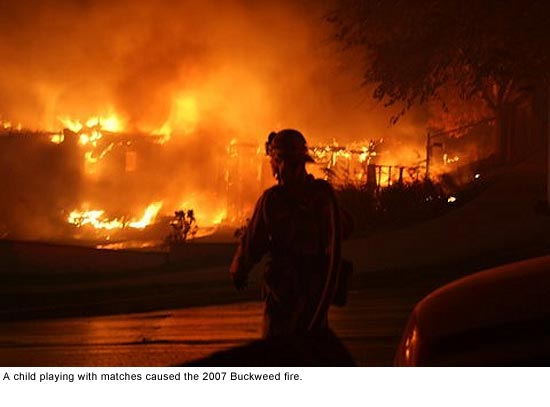Reaching kids before spark explodes
August 3, 2011
In the summer of 2008, three teenaged boys climbed a hill with a half-dozen big firecrackers. It was July in Pasadena and the slope was tinder dry. Later, they would say that they weren’t thinking about fire hazards as one pulled out a cherry bomb and let another one light it—they just wanted “to make a lot of noise.”
In a backyard patio not far from the hillside, a neighbor heard an explosion and then saw flames rising. Next door, a 911 caller reported yelling and “high-fiving” as the boys ran away. The flames were out of control within minutes; they consumed five acres of the Angeles National Forest before firefighters stopped them. Two of the three juveniles were subsequently convicted of arson.
Though the harshness of the conviction was unusual, the incident wasn’t. According to the Burn Institute in San Diego, minors account for more than 50% of all arson arrests in the nation. A 2010 report for the National Fire Protection Association found that in the year of that Pasadena incident, children playing with fire started some 53,500 conflagrations, causing some $279 million in property damage, 70 civilian deaths and 910 injuries.
That’s why a modest $148,760 grant approved this week by the Board of Supervisors is being welcomed at the Los Angeles County Fire Department. Earmarked for a special program in intervention and one-on-one counseling of juvenile fire setters, it will increase by several orders of magnitude the number of county firefighters who are trained to deal with an ongoing hazard, particularly in fire-prone communities.
“It’s a program we’ve always had, but our ability to train firefighters in these skills has ebbed and flowed over the years,” says Chief Deputy John Tripp, who commands the department’s emergency operations. At the moment, Tripp says, the department has “maybe a dozen” firefighters who have received the special training necessary to intervene when a fire turns out to have been caused by a minor.
“That limited a number of people is of questionable effectiveness when you’re trying to protect 4 million people,” he says.
Administered by the Federal Emergency Management Agency and the U.S. Department of Homeland Security, the grant—which will be matched by a $37,190 contribution from the county—will allow the department to offer 32 hours of special training to 66 firefighters sometime early next year.
As Juvenile Fire Setter Intervention specialists, those firefighters will then be able to make the necessary assessments when a child starts a fire, bringing a child and his or her family in to the fire station for one-on-one counseling and education or, in more serious cases, referring the child for more extensive professional treatment.
Most fires are accidental, Tripp says, and fires started by children are usually the result of “naïveté about the danger.” But playing with fire can also be a sign of psychological problems.
“The statistics show that without intervention, a lot of juvenile fire-setters will start fires again,” says Heidi Oliva, a civilian administrative services manager for the department who helped shepherd the grant.
Oliva has firsthand experience with the risks of juvenile fire setters. In October, 2007, she and her husband had to flee their Santa Clarita home with a 4-year-old and an infant when stiff Santa Ana winds swept the Buckweed Fire down from Agua Dulce. The fire destroyed 38,000 acres and 21 homes.
Its cause? A 10-year-old child playing with a pack of matches. The child eventually moved and prosecutors chose not to file charges; authorities must prove intent to cause harm in order to charge someone with arson, and that can be difficult with young children.
But the lessons of that fire and others are instructive, Tripp says.
“Fire is a natural foe and a danger to everyone in our community all the time, and if we can step in at the start of a dangerous behavior, we need to do that. Otherwise, a small situation can become a larger, more dangerous one.”
Posted 8/3/11













 405 bridge work causes a stink
405 bridge work causes a stink
